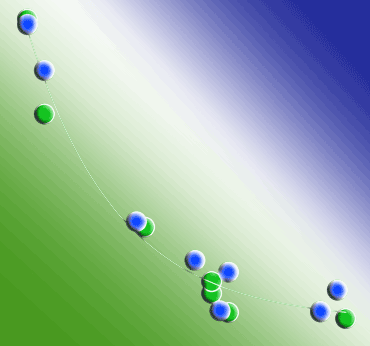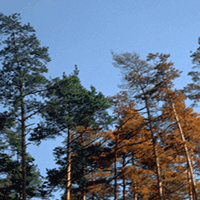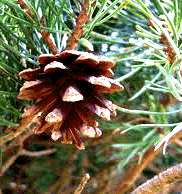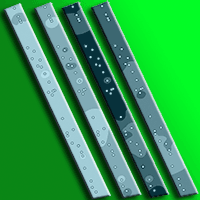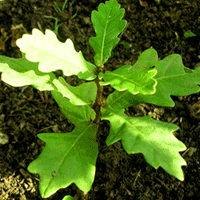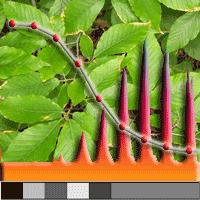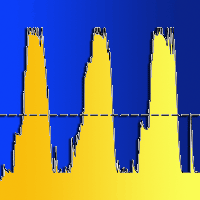
Use of δ13C as water stress indicator and potential silvicultural decision support tool in Pinus radiata stand management in South Africa
Phillip M Fischer (1-2), Ben du Toit (1)
iForest - Biogeosciences and Forestry, Volume 12, Issue 1, Pages 51-60 (2019)
doi: https://doi.org/10.3832/ifor2628-011
Published: Jan 24, 2019 - Copyright © 2019 SISEF
Research Articles
Abstract
In this study, the carbon isotope ratio in tree rings was investigated as a potential measure of water availability and drought stress in Pinus radiata stands in South Africa. An understanding of water availability and its variation in space is fundamental to the implementation of increasingly site-specific management regimes that have the potential to improve stand productivity. Fourteen plantation compartments, situated on water shedding (convex) terrain were identified where reliable weather data existed and a water balance model could be run. This output was used to derive water stress indicators: (a) relative canopy conductance (gc/gcmax) and (b) the ratio of actual to potential evapotranspiration (ETa/ETp). The water stress indicators (calculated per year of growth) were related to δ13C values in five tree rings formed in the five years before mid-rotation thinning took place. The water balance model used adequately described soil water availability throughout each growing season and indicated that most severe stand water stress occurred during the summer months of the study period (November to April). The ETa/ETp ratio for this period as well as the relative canopy conductance proved to be good measures of water stress. The 5-year averages of the ETa/ETp ratios (taken over the driest 6 month period) ranged from 0.17 to 0.32 (winter rainfall zone) and 0.44 to 0.70 (all-year rainfall zone). The 5-year averages of ETa/ETp ratios could be accurately predicted (p< 0.0001; adjusted r2 = 0.83) with multiple regression using δ13C values in whole-wood samples (i.e., earlywood and latewood) and the site index of stands (where site index is the average height of the dominant 20% trees in the stand at base age 20). The δ13C values in tree rings across the planted range of P. radiata in South Africa can therefore be used to identify broad categories of water availability for purposes of increasingly site-specific silvicultural management.
Keywords
Stable Carbon Isotope, Tree Rings, Water Availability, Drought Stress, Site-specific Forest Management, Monterey Pine
Authors’ Info
Authors’ address
Ben du Toit
Department of Forest and Wood Science, University of Stellenbosch, Private Bag X1, Matieland, Stellenbosch, 7602 (South Africa)
Sappi Forests (Pty) Ltd, P.O. Box 372, Ngodwana, 1209 (South Africa)
Corresponding author
Paper Info
Citation
Fischer PM, du Toit B (2019). Use of δ13C as water stress indicator and potential silvicultural decision support tool in Pinus radiata stand management in South Africa. iForest 12: 51-60. - doi: 10.3832/ifor2628-011
Academic Editor
Tamir Klein
Paper history
Received: Sep 08, 2017
Accepted: Nov 15, 2018
First online: Jan 24, 2019
Publication Date: Feb 28, 2019
Publication Time: 2.33 months
Copyright Information
© SISEF - The Italian Society of Silviculture and Forest Ecology 2019
Open Access
This article is distributed under the terms of the Creative Commons Attribution-Non Commercial 4.0 International (https://creativecommons.org/licenses/by-nc/4.0/), which permits unrestricted use, distribution, and reproduction in any medium, provided you give appropriate credit to the original author(s) and the source, provide a link to the Creative Commons license, and indicate if changes were made.
Web Metrics
Breakdown by View Type
Article Usage
Total Article Views: 46301
(from publication date up to now)
Breakdown by View Type
HTML Page Views: 37775
Abstract Page Views: 4086
PDF Downloads: 3641
Citation/Reference Downloads: 1
XML Downloads: 798
Web Metrics
Days since publication: 2511
Overall contacts: 46301
Avg. contacts per week: 129.07
Citation Metrics
Article Citations
Article citations are based on data periodically collected from the Clarivate Web of Science web site
(last update: Mar 2025)
Total number of cites (since 2019): 8
Average cites per year: 1.14
Publication Metrics
by Dimensions ©
Articles citing this article
List of the papers citing this article based on CrossRef Cited-by.
References
Crop evapotranspiration: guidelines for computing crop water requirements. FAO Irrigation and drainage paper no. 56, FAO, Rome, Italy, pp. 300.
Gscholar
Growth responses to fertiliser application of thinned mid-rotation Pinus radiata stands across a soil water availability gradient in the Boland area of the Western Cape. MSc Thesis, Dept. of Forest and Wood Science, Stellenbosch University, Stellenbosch, South Africa, pp. 100.
Gscholar
Information requirements to fertilize plantations with greater precision in a dry country. In: Proceedings of the Symposium “Precision Forestry in Plantations, Semi-Natural and Natural Forests” (Ackerman PA, Längin DW, Antonides MC eds)., Stellenbosch (South Africa) 5-10 March 2006. Stellenbosch University, Stellenbosch, South Africa, pp. 245-260.
Gscholar
Matching site, species and silvicultural regime to optimise the productivity of commercial softwood species in Southern Africa. In: “South African Forestry Handbook (5th edn)” (Bredenkamp BV, Upfold S eds). Southern African Institute of Forestry, Pretoria, South Africa, pp. 43-49.
Gscholar
Simultaneous assessment, through sap flow and stable isotopes, of water use efficiency (WUE) in thinned pines shows improvement in growth, tree-climate sensitivity and WUE, but not in WUEi. Forest Ecology and Management 361: 298-308.
CrossRef | Gscholar
δ13C as indicator of soil water availability and drought stress in Pinus radiata stands in South Africa. MSc thesis, Dept. of Forest and Wood Science, Stellenbosch University, Stellenbosch, South Africa, pp. 108.
Gscholar
Handbook of standard soil testing methods for advisory purposes. Non-Affiliated Soil Analyses Work Committee (NA-SAWC), Soil Science Society of South Africa, Sunnyside, Pretoria, South Africa, pp. 160.
Gscholar
A model for site specific estimation of the available soil water content and the evapotranspiration in forest ecosystems. Journal of Environmental Hydrology 11 (7): 1-14.
Gscholar

